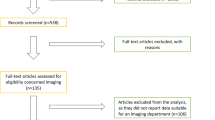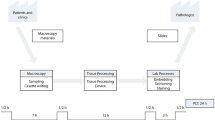Abstract
Lean is a comprehensive system of management based on the Toyota production system (TPS), encompassing all the activities of an organization. It focuses management activity on creating value for the end-user by continuously improving operational effectiveness and removing waste. Lean management creates a culture of continuous quality improvement with a strong emphasis on developing the problem-solving capability of staff using the scientific method (Deming’s Plan, Do, Check, Act cycle). Lean management systems have been adopted by a number of histopathology departments throughout the world to simultaneously improve quality (reducing errors and shortening turnround times) and lower costs (by increasing efficiency). This article describes the key concepts that make up a lean management system, and how these concepts have been adapted from manufacturing industry and applied to histopathology using a case study of lean implementation and evidence from the literature. It discusses the benefits, limitations, and pitfalls encountered when implementing lean management systems.







Similar content being viewed by others
References
Womack JP, Jones DT, Roos D (2007) The machine that changed the world: the story of lean production—Toyota’s secret weapon in the global car wars that is revolutionizing world industry. Free Press, New York
Womack JP, Jones DT (2003) Lean thinking banish waste and create wealth in your corporation. Free Press, New York
Jones DT, Womack JP (2007) Lean solutions: how companies and customers can create value and wealth together, Simon and Schuster
Spear SJ (2005) Fixing health care from the inside, today. Harv Bus Rev 83(9):78–91 158
Kruskal JB, Reedy A, Pascal L, Rosen MP, Boiselle PM (2012) Quality initiatives: lean approach to improving performance and efficiency in a radiology department. Radiographics 32(2):573–587
Toussaint JS, Berry LL (2013) The promise of lean in health care. Mayo Clin Proc 88(1):74–82
Womack JP, Miller D (2005) Going lean in health care. Institute for Healthcare Improvement Cambridge, MA
Clark DM, Silvester K, Knowles S (2013) Lean management systems: creating a culture of continuous quality improvement. J Clin Pathol 66(8):638–643
Sun GH, MacEachern MP, Perla RJ, Gaines JM, Davis MM, Shrank WH (2014) Health care quality improvement publication trends. Am J Med Qual 29(5):403–407
Condel JL, Sharbaugh DT, Raab SS (2004) Error-free pathology: applying lean production methods to anatomic pathology. Clin Lab Med 24(4):865–899
Raab SS, Grzybicki DM, Condel JL, Stewart WR, Turcsanyi BD, Mahood LK, Becich MJ (2008) Effect of lean method implementation in the histopathology section of an anatomical pathology laboratory. J Clin Pathol 61(11):1193–1199
Serrano L, Hegge P, Sato B, Richmond B, Stahnke L (2010) Using LEAN principles to improve quality, patient safety, and workflow in histology and anatomic pathology. Adv Anat Pathol 17(3):215–221
Buesa RJ (2009) Adapting lean to histology laboratories. Ann Diagn Pathol 13(5):322–333
Zarbo RJ, DAngelo R (2007) The Henry Ford production system effective reduction of process defects and waste in surgical pathology. Am J Clin Pathol 128(6):1015–1022
Emiliani B (2007) Real lean, CLBM
Liker JK, Franz JK (2011) The Toyota way to continuous improvement: linking strategy and operational excellence to achieve superior performance. McGraw-Hill, New York
Spear S, Bowen HK (1999) Decoding the DNA of the Toyota production system. Harv Bus Rev 77:96–108
Liker JK (2004) The Toyota way: 14 management principles from the world’s greatest manufacturer. McGraw-Hill, New York
Senge PM (2006) The fifth discipline: the art and practice of the learning organization. Doubleday/Currency, New York
Rother M (2010) Toyota kata: managing people for improvement, adaptiveness, and superior results. McGraw Hill, New York
Rother M, Shook J (2003) Learning to see: value stream mapping to add value and eliminate muda, Lean Enterprise Institute
Nash MA, Poling SR (2008) Mapping the total value stream: a comprehensive guide for production and transactional processes. CRC Press, Boca Raton
Smith ML, Wilkerson T, Grzybicki DM, Raab SS (2012) The effect of a lean quality improvement implementation program on surgical pathology specimen accessioning and gross preparation error frequency. Am J Clin Pathol 138(3):367–373
Zarbo RJ (2012) Creating and sustaining a lean culture of continuous process improvement. Am J Clin Pathol 138(3):321–326
Zarbo RJ (2010) Leaders wanted a call to change the status quo in approaching health care quality, once again. Am J Clin Pathol 134(3):361–365
Deming WE (2000) Out of the crisis. MIT Press, Cambridge, MA
Bicheno J (2008) The lean toolbox for service systems. PICSIE Books
Hughes R (2012) Using visual management to deliver standardised work: a look at A3 SOPS. The Biomedical Scientist. 110–112.
Shook J (2008) Managing to learn: using the A3 management process to solve problems, gain agreement, mentor and lead. Lean Enterprise Institute, Cambridge, MA
Sobek II DK, Smalley A (2011) Understanding A3 thinking: a critical component of Toyota’s PDCA management system. CRC Press
Shook J (2009) Toyota’s secret: the A3 report. MIT Sloan Manag Rev 50(4):30–33
Jimmerson C (2007) A3 problem solving for healthcare: a practical method for eliminating waste. Productivity Press
Zarbo RJ (2012) Creating and sustaining a lean culture of continuous process improvement. Am J Clin Pathol 138(3):321–326
Layfield LJ, Anderson GM (2010) Specimen labeling errors in surgical pathology: an 18-month experience. Am J Clin Pathol 134(3):466–470
Zarbo RJ, Tuthill JM, D’Angelo R, Varney R, Mahar B, Neuman C, Ormsby A (2009) The Henry Ford production system: reduction of surgical pathology in-process misidentification defects by bar code-specified work process standardization. Am J Clin Pathol 131(4):468–477
Nakhleh RE, Idowu MO, Souers RJ, Meier FA, Bekeris LG (2011) Mislabeling of cases, specimens, blocks, and slides: a college of American pathologists study of 136 institutions. Arch Pathol Lab Med 135(8):969–974
NHS Improvement (2010) Learning how to achieve a seven day turnaround time in histopathology. www.nhsiq.nhs.uk/download.ashx?mid=8523&nid=8522. Accessed 30 June 2015.
Kotter JP (1995) Leading change: why transformation efforts fail. Harv Bus Rev 73(2):59–67
Kaplan GS, Patterson SH, Ching JM, Blackmore CC (2014) Why lean doesn’t work for everyone. BMJ Qual Saf 23(12):970–973
Author information
Authors and Affiliations
Corresponding author
Rights and permissions
About this article
Cite this article
Clark, D. Quality improvement in basic histotechnology: the lean approach. Virchows Arch 468, 5–17 (2016). https://doi.org/10.1007/s00428-015-1838-0
Received:
Accepted:
Published:
Issue Date:
DOI: https://doi.org/10.1007/s00428-015-1838-0




